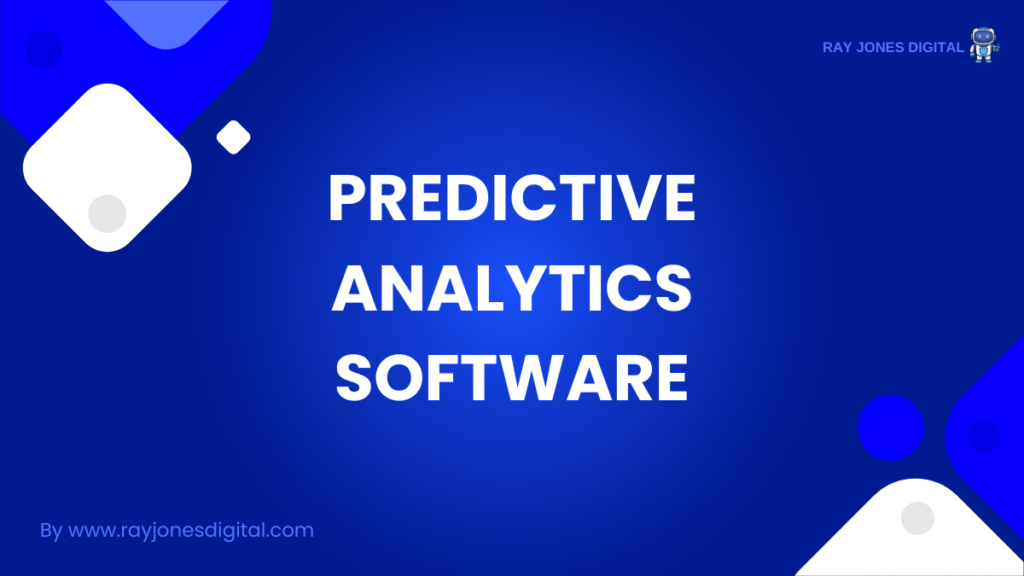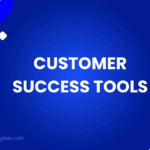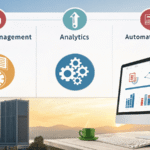
The ability to predict future trends, customer behaviour, and market shifts has become essential for business success. Predictive analytics software transforms raw data into actionable insights, helping organisations make informed decisions before opportunities slip away.
But with hundreds of predictive analytics platforms available, choosing the right one can feel overwhelming. This comprehensive guide examines the leading predictive analytics software options for 2025, breaking down their capabilities, strengths, and ideal use cases to help you make the best choice for your organisation.
What Defines Exceptional Predictive Analytics Software?
The most effective predictive analytics platforms share several critical characteristics that separate them from basic reporting tools.
Advanced Machine Learning Capabilities
Top-tier predictive analytics software employs sophisticated machine learning algorithms that can identify complex patterns in large datasets. These platforms don’t just show you what happened—they predict what’s likely to happen next with measurable accuracy.
User-Friendly Interface Design
The best predictive analytics tools balance powerful functionality with intuitive design. Business users should be able to build models and interpret results without requiring extensive technical training or data science expertise.
Real-Time Data Processing
Modern predictive analytics software processes data as it arrives, enabling real-time insights and immediate response to changing conditions. This capability is crucial for industries like finance, retail, and manufacturing where timing affects outcomes.
Scalability and Integration
Leading platforms scale seamlessly from small datasets to enterprise-level data volumes. They integrate smoothly with existing business systems, databases, and cloud platforms without disrupting current workflows.
Top Predictive Analytics Software Platforms
IBM Watson Studio
IBM Watson Studio continues to dominate the enterprise predictive analytics market with its comprehensive artificial intelligence and machine learning capabilities. The platform excels at handling complex datasets and delivering sophisticated predictive models.
Key Features:
- AutoAI functionality that automatically builds and optimises models
- Support for multiple programming languages including Python, R, and Scala
- Built-in data visualisation and exploration tools
- Enterprise-grade security and governance features
Why Organisations Choose Watson Studio:
The platform’s strength lies in its ability to handle extremely complex predictive modelling tasks. Large enterprises appreciate the robust governance features and the ability to deploy models across hybrid cloud environments.
Best For: Enterprise organisations with complex data environments and dedicated data science teams.
Microsoft Azure Machine Learning
Microsoft’s Azure Machine Learning platform has gained significant traction among businesses already invested in the Microsoft ecosystem. The platform offers both code-first and low-code approaches to predictive analytics.
Key Features:
- Drag-and-drop model building interface
- AutoML capabilities for automated model selection
- Seamless integration with Microsoft Office and Power BI
- Extensive library of pre-built algorithms
Why Organisations Choose Azure ML:
The platform’s integration with familiar Microsoft tools reduces the learning curve significantly. Businesses appreciate the ability to build predictive models using the same environment where they already manage data and create reports.
Best For: Organisations heavily invested in Microsoft technologies and those seeking strong integration with existing workflows.
Tableau with Einstein Analytics
Tableau’s acquisition by Salesforce brought Einstein Analytics capabilities into the popular data visualisation platform. This combination creates a powerful predictive analytics solution that’s particularly strong for customer-focused predictions.
Key Features:
- AI-powered insights and anomaly detection
- Natural language query capabilities
- Extensive data connector library
- Advanced statistical functions
Why Organisations Choose Tableau:
The platform excels at making predictive analytics accessible to business users. The visual approach to building models appeals to teams that prefer graphical interfaces over code-based solutions.
Best For: Marketing teams, sales organisations, and businesses prioritising user-friendly analytics tools.
H2O.ai
H2O.ai has built a reputation as a leading open-source predictive analytics platform that delivers enterprise-grade capabilities. The platform appeals to organisations wanting cutting-edge machine learning without vendor lock-in.
Key Features:
- Automatic machine learning (AutoML) capabilities
- Support for distributed computing
- Model interpretability and explainability features
- Integration with popular data science tools
Why Organisations Choose H2O.ai:
The platform’s open-source foundation provides transparency and flexibility that many data science teams value. The automatic machine learning features enable rapid model development and deployment.
Best For: Data science teams, organisations prioritising open-source solutions, and companies with significant technical expertise.
SAS Advanced Analytics
SAS remains a dominant force in predictive analytics, particularly in heavily regulated industries. The platform offers comprehensive statistical analysis capabilities alongside modern machine learning features.
Key Features:
- Extensive statistical procedure library
- Visual model building interface
- Robust data management capabilities
- Industry-specific analytical solutions
Why Organisations Choose SAS:
The platform’s long history and proven track record in industries like banking, healthcare, and government create confidence in mission-critical applications. The comprehensive statistical capabilities appeal to traditional analysts.
Best For: Financial services, healthcare, government agencies, and organisations requiring proven analytical capabilities.
Understanding Different Types of Predictive Analytics
Predictive analytics encompasses several distinct approaches, each suited to different business challenges and data types.
Classification Models
Classification models predict which category something belongs to. Examples include determining whether a customer will churn, if an email is spam, or whether a loan applicant poses a credit risk.
Regression Models
Regression models predict numerical values, such as sales forecasts, price predictions, or demand planning. These models are particularly valuable for financial planning and inventory management.
Time Series Forecasting
Time series models analyse data points collected over time to predict future values. Common applications include stock price prediction, weather forecasting, and seasonal demand planning.
Clustering Analysis
Clustering identifies groups of similar items within datasets. Businesses use clustering for customer segmentation, market research, and anomaly detection.
Implementation Strategies for Predictive Analytics Software
Successful predictive analytics implementation requires careful planning and realistic expectations about capabilities and limitations.
Start with Clear Business Objectives
Define specific business problems you want to solve before selecting software. Whether you’re trying to reduce customer churn, optimise pricing, or improve supply chain efficiency, clear objectives guide platform selection and implementation.
Assess Your Data Quality
Predictive analytics software is only as good as the data it analyses. Audit your data sources for completeness, accuracy, and consistency. Plan data cleaning and preparation processes before beginning model development.
Consider Your Team’s Technical Skills
Match software complexity to your team’s capabilities. Platforms like Tableau work well for business users, while tools like H2O.ai require more technical expertise. Consider training requirements and ongoing support needs.
Plan for Model Maintenance
Predictive models require ongoing monitoring and updates as business conditions change. Factor in resources for model maintenance, retraining, and performance monitoring.
Evaluating Predictive Analytics Software
When comparing platforms, consider these critical evaluation criteria:
Accuracy and Performance
Test platforms with your actual data to evaluate prediction accuracy. Consider both the quality of predictions and the speed of model training and deployment.
Ease of Use
Evaluate how quickly your team can become productive with each platform. Consider the learning curve for both technical and business users.
Integration Capabilities
Assess how well each platform integrates with your existing data sources, business applications, and reporting tools. Poor integration can create significant ongoing challenges.
Scalability
Consider your current data volumes and growth projections. Ensure the platform can handle your expected data growth without performance degradation.
Cost Structure
Understand the total cost of ownership, including licensing, infrastructure, training, and ongoing support. Some platforms charge based on data volume, while others use per-user pricing.
Common Implementation Challenges and Solutions
Most organisations encounter similar challenges when implementing predictive analytics software. Understanding these challenges helps you plan more effectively.
Data Integration Complexity
Combining data from multiple sources often proves more challenging than expected. Plan for data integration work and consider platforms with strong data preparation capabilities.
Model Interpretability
Business stakeholders need to understand how models reach conclusions. Choose platforms that provide model explanations and visualisations that non-technical users can understand.
Change Management
Predictive analytics changes how decisions are made. Prepare your organisation for this shift by involving stakeholders in the selection process and providing adequate training.
Unrealistic Expectations
Predictive analytics provides probabilities, not certainties. Set realistic expectations about accuracy and help stakeholders understand the limitations of predictive models.
The Future of Predictive Analytics
Predictive analytics software continues evolving rapidly, with several trends shaping the industry’s future.
Automated Machine Learning
AutoML capabilities are becoming more sophisticated, enabling business users to build complex models without extensive technical knowledge. This trend democratises predictive analytics across organisations.
Real-Time Predictions
Streaming analytics and edge computing enable real-time predictions at the point of decision. This capability is particularly valuable for fraud detection, personalisation, and operational optimisation.
Explainable AI
As predictive models become more complex, the need for interpretability grows. New techniques make sophisticated models more transparent and trustworthy.
Industry-Specific Solutions
Predictive analytics platforms are increasingly offering industry-specific templates, models, and integrations that reduce implementation time and improve outcomes.
Making Your Software Selection Decision
Choosing the right predictive analytics software requires balancing multiple factors including technical requirements, budget constraints, and organisational capabilities.
Start by clearly defining your use cases and success metrics. Create a shortlist of platforms that align with your technical requirements and budget. Test each platform with your actual data to evaluate performance and usability.

I am Ray Jones Digital
My current occupations: a Digital Marketer, Local SEO expert, Link Builder, and WordPress SEO specialist. Shopify SEO, Ecommerce Store Management, and HTML & WordPress Developer I have been practicing the above mentioned services for more than 10 years now As an SEO expert working with your ongoing projects.



